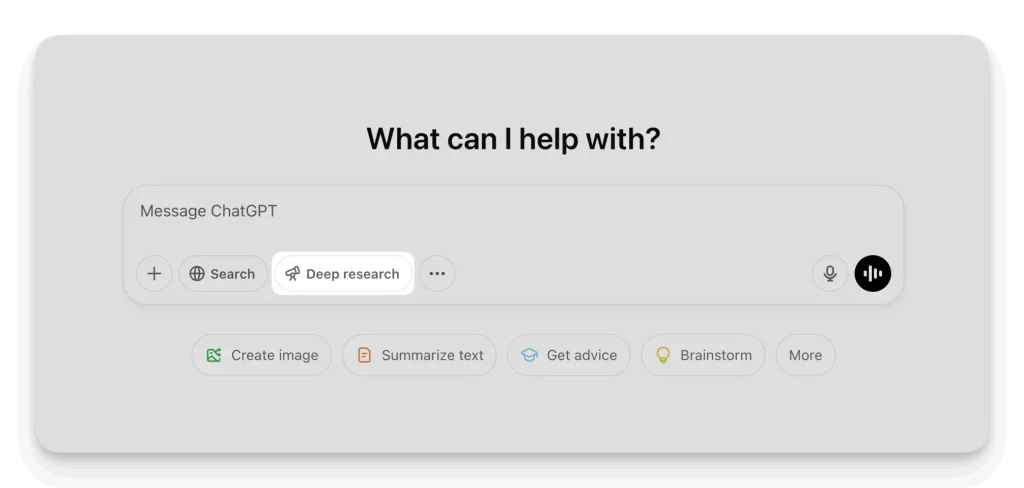How California is transforming public services with Google Cloud
State and local governments across the nation face a myriad of challenges, including strained budgets,

We recognize the growing need for tools that can efficiently analyze and synthesize the immense volume of information available online. OpenAI’s Deep Research feature has quickly become a sought-after capability, enabling users to generate comprehensive, cited research reports on virtually any topic¹. With the launch of a lightweight Deep Research tool, this advanced function is now available to every ChatGPT user, regardless of subscription status.
Deep Research is designed to perform in-depth, multi-step investigations using public web data. Unlike a standard chatbot response, it works in the background, scanning articles, PDFs, and images, then compiles findings into a structured, referenced report². This approach supports a wide range of needs, from business intelligence to academic research and personal projects¹.
The lightweight Deep Research tool leverages OpenAI’s o4-mini model-a smaller, more cost-effective version of the company’s advanced AI². While it may not match the full power of the original Deep Research tool, OpenAI asserts that it is “nearly as intelligent” and preserves the depth and quality users expect. The main difference lies in response length; reports are generally more concise, but the core analytical value remains intact.
When a user initiates a Deep Research query, the tool embarks on a multi-step process:
This process can take several minutes-often between 5 and 30-reflecting the complexity and thoroughness of the task¹. The tool’s ability to self-fact-check and reason through steps ensures accuracy and reliability, making it a valuable asset for anyone seeking trustworthy information².

OpenAI’s commitment to accessibility is reflected in the new tiered structure for Deep Research usage:
Usage limits reset every 30 days. The first time Deep Research is used, a 30-day window begins, and limits refresh at the end of that period³.
The lightweight Deep Research tool is built for versatility. Here are some ways it supports different needs:
Leaders and analysts can use Deep Research to compile competitive intelligence, analyze financial reports, or track trends. For example, by uploading a public earnings call transcript, users can prompt the tool to extract insights and recommend actionable strategies².
Students and educators benefit from Deep Research’s ability to summarize complex topics, gather literature reviews, and cite relevant sources. The tool’s multi-step reasoning ensures that reports are not only comprehensive but also verifiable¹’².
Writers and creators can use Deep Research to gather background information, fact-check articles, or explore new subjects. The tool’s concise, referenced reports streamline the research process and enhance content quality.
Accessing Deep Research is straightforward:
1. In ChatGPT, select ‘Deep research’ when entering your query.
2. Describe your research need-such as a market analysis or a product comparison.
3. Optionally, attach images, files, or spreadsheets to provide context.
4. The tool may generate a form to capture specific parameters, refining its focus.
5. Once started, a sidebar displays the tool’s thought process and the sites it visits.
6. After completion, users receive a detailed, cited report.

OpenAI’s move to democratize Deep Research comes as other major AI providers, including Google (Gemini), Microsoft (Copilot), and xAI (Grok), roll out similar features¹. These tools are powered by reasoning models capable of problem-solving and self-fact-checking, but OpenAI’s lightweight Deep Research stands out for its broad accessibility and cost efficiency.
While some competitors offer higher daily limits (e.g., Gemini’s 20 uses per day on its Advanced plan), OpenAI’s approach balances thoroughness with responsible usage, ensuring the infrastructure can support millions of users without compromising quality.
OpenAI’s lightweight Deep Research tool signals a shift toward making advanced AI analysis available to everyone. By lowering operational costs and expanding access, OpenAI enables more users to benefit from in-depth, multi-source research. This democratization supports informed decision-making, critical thinking, and innovation across industries¹.
As AI continues to evolve, we anticipate further enhancements in Deep Research capabilities, including faster response times, greater customization, and even more robust fact-checking. For now, the lightweight Deep Research tool represents a significant step forward in empowering users to navigate the information age with confidence².
Citations
1. Wiggers, Kyle. “OpenAI rolls out a ‘lightweight’ version of its ChatGPT deep research tool.” TechCrunch, 24 Apr. 2025.
2. Bonifacic, Igor. “OpenAI’s Deep Research tool is coming to free accounts.” Engadget, 25 Apr. 2025.
3. “Free ChatGPT users are finally getting Deep Research access from today, but there are restrictions.” TechRadar, 25 Apr. 2025.
The post OpenAI Broadens Access: Lightweight Deep Research Empowers Every ChatGPT User appeared first on AI GPT Journal.
Author: Jim Malervy -
State and local governments across the nation face a myriad of challenges, including strained budgets,
A new report from SNS Telecom & IT indicates that private 5G networks are on
Trading in capital markets demands peak compute performance, with every microsecond impacting critical decisions and
An AI Growth Zone in the North East is set to unlock more than 5,000
Key takeaways Projects in ChatGPT: a simple way to keep work on track OpenAI has…